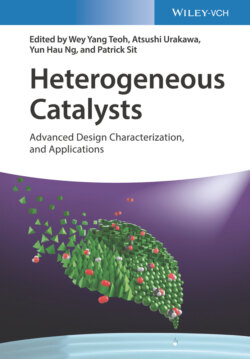Читать книгу Heterogeneous Catalysts - Группа авторов - Страница 55
4.3.1 Deposition of Colloidal Nanoparticles
ОглавлениеRecent advances in colloidal synthesis have enabled preparing monometallic or bimetallic nanoparticles (e.g. alloys, core–shell structures) with well‐defined structures and sizes. These nanocrystals have ligands or capping agents that need to be removed prior to catalysis to increase the activity, although in some cases the ligands can be reaction promoters when chosen judiciously. In general, the two main challenges to prepare an efficient and practical catalyst from colloidal nanoparticles are: (i) to uniformly disperse the nanoparticles on a support and (ii) the subsequent activation by the removal of the ligand using thermal treatment or mild oxidation. Carbon supports such as CNT or graphene are ideal supports to deposit preformed nanoparticles since the absence of microporosity and open porosity favors the infiltration of the nanoparticles to all the deep surfaces of the carbon material. To disperse the nanocrystals uniformly on a carbon support, the particle–support and particle–particle interactions should be balanced. If the interaction of the particles between themselves is stronger than with the support, the particles will tend to aggregate. The amount of ligand and the temperature can tune the strength of interactions of the nanoparticles with the support as demonstrated in the assembly of Fe nanocrystals on CNT [42]. To develop an active catalyst and make the metal accessible to reactants, the capping agent must be removed by thermal treatment or mild oxidation. The problem is that in this step, the nanoparticles may begin to coalesce. Therefore, the particles can change their size and shape if the oxidation step is severe. Therefore, the ligand should be removed under milder conditions as possible. In principle, stabilization should be achieved more easily on a carbon material with a higher amount of defects and oxygenated surface groups than on undefective graphitic carbon materials because the former has more anchoring sites for the nanoparticles after removing the capping agent. The removal of ligands is even more difficult for transition metals than for noble metal nanocrystals since the ligands usually bind stronger to the former.
